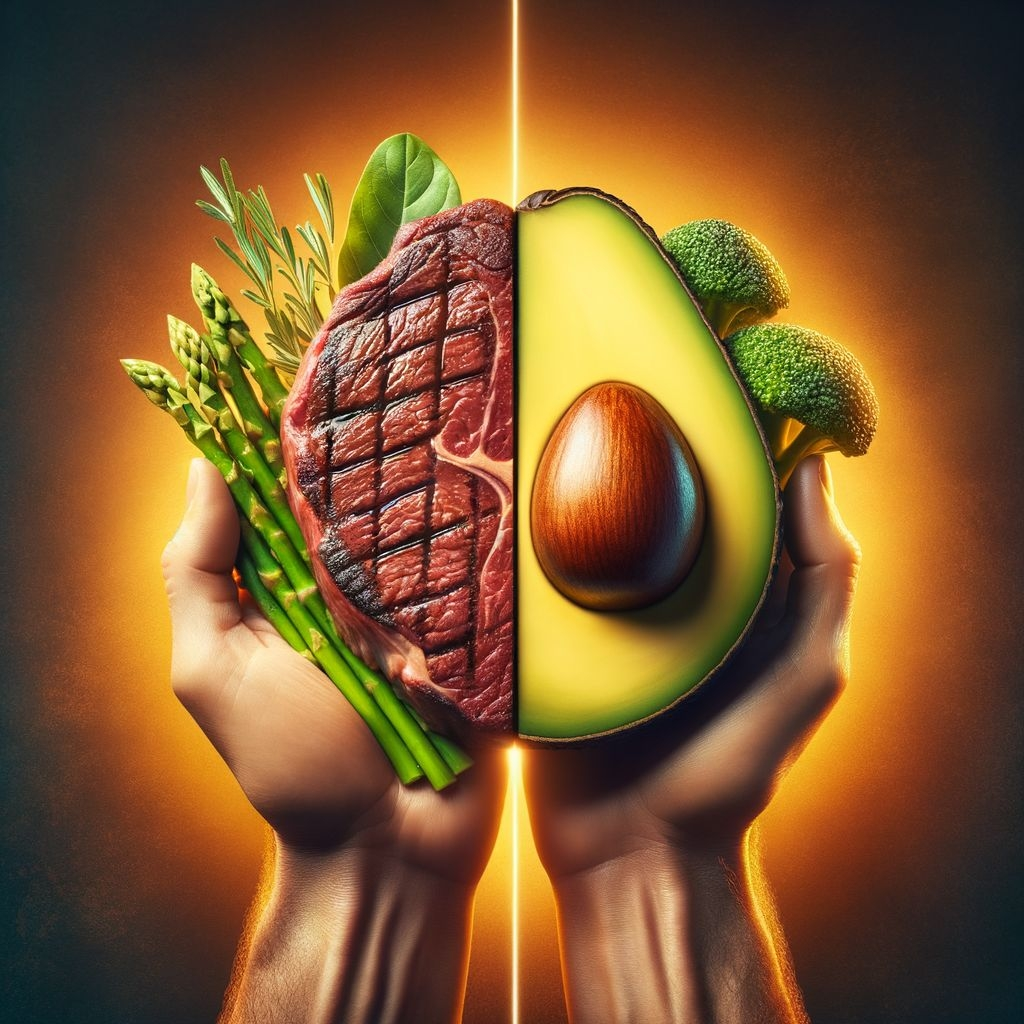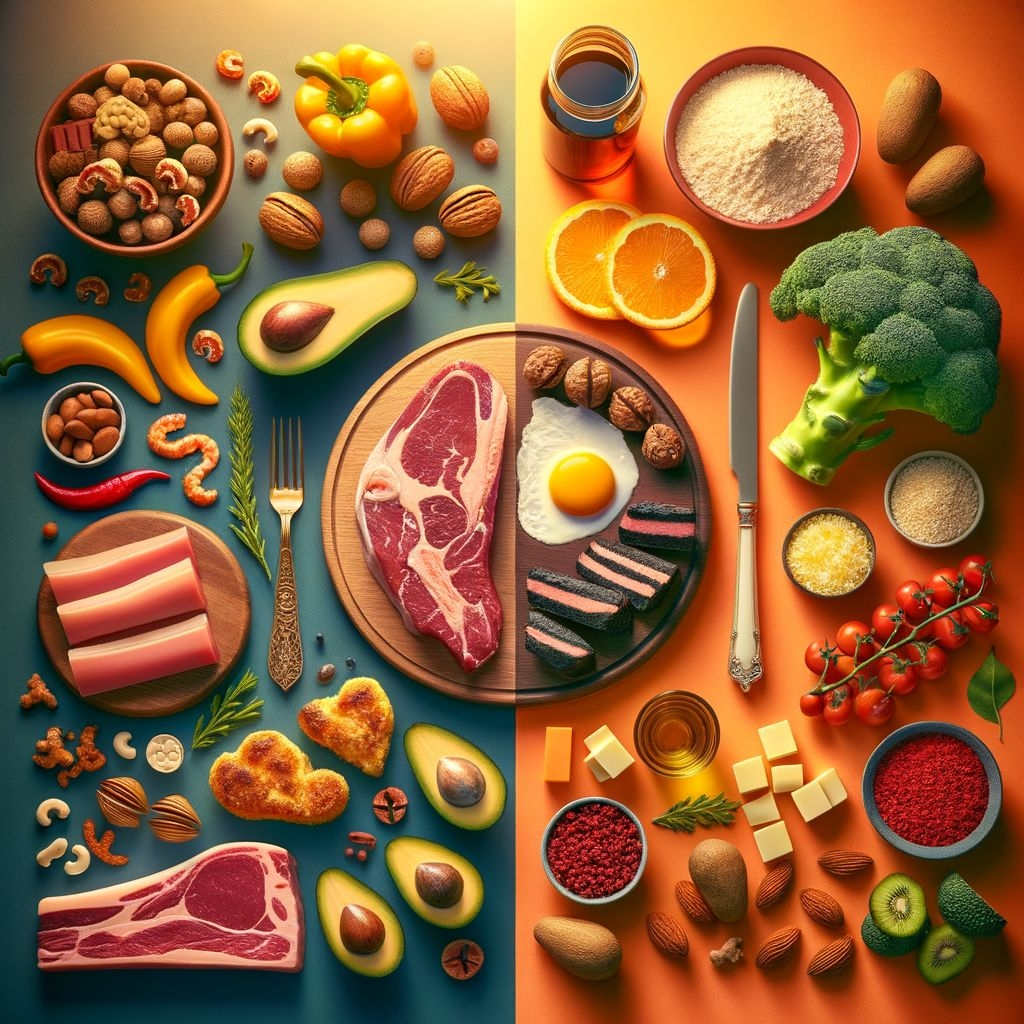Carnivore Diet vs Keto Diet: Which Diet is Best for You?
Choosing the right diet plan can greatly impact your health and well-being. In this comprehensive guide, we will delve into the differences and benefits of the Carnivore Diet and the Keto Diet, helping you make an informed decision tailored to your unique dietary needs.
The Carnivore Diet is a high-fat, low-carbohydrate diet that primarily consists of animal products such as meat, fish, eggs, and dairy. The main premise of the diet is to eliminate all plant-based foods, including fruits, vegetables, grains, legumes, nuts, and seeds. Supporters of the Carnivore Diet claim that it can improve digestion, promote weight loss, increase energy levels, and reduce inflammation.
On the other hand, the Keto Diet is a low-carbohydrate, moderate-protein, high-fat diet that aims to put the body into a state of ketosis, where it burns fat for energy instead of carbohydrates. The Keto Diet involves consuming foods such as meat, fish, eggs, dairy, healthy fats, and non-starchy vegetables while limiting or avoiding grains, sugar, fruit, and processed foods. Proponents of the Keto Diet tout its ability to promote weight loss, stabilize blood sugar levels, improve mental clarity, and boost overall health.
Understanding the Differences Between Carnivore Diet and Keto Diet
What is the Carnivore Diet and how does it differ from the Keto Diet?
The Carnivore Diet is a zero-carb, high-fat diet that emphasizes animal products while eliminating plant-based foods. On the other hand, the Keto Diet, or ketogenic diet, is a low-carb diet that focuses on entering a metabolic state of ketosis by reducing carbohydrate intake. While both diets may have some overlapping benefits, such as weight loss and improved energy levels, they have some key differences.
The Carnivore Diet is extremely restrictive, as it only allows for the consumption of animal products like meat, fish, eggs, and dairy. This means that fruits, vegetables, grains, and legumes are not allowed on this diet.
On the other hand, the Keto Diet allows for some low-carb vegetables, nuts, seeds, and healthy fats to be included in the diet. This means that there is more variety in the foods that can be eaten on a ketogenic diet compared to the Carnivore Diet.
Furthermore, the goal of the Carnivore Diet is to eliminate all carbohydrates from the diet, while the Keto Diet aims to keep carbohydrate intake low enough to enter a state of ketosis. Ketosis is a metabolic state in which the body burns fat for fuel instead of carbohydrates, which can lead to weight loss and other health benefits.
Ultimately, both diets have their own set of rules and restrictions, so it’s important to choose the one that aligns with your health goals and preferences. It’s also essential to consult with a healthcare professional before starting any new diet to ensure that it is safe and appropriate for your individual needs.

Benefits of a Carnivore Diet compared to a Keto Diet
The Carnivore Diet may offer benefits such as improved ability to burn fat, while the Keto Diet is known for its potential to aid in weight loss and maintaining stable blood sugar levels. Both diets emphasize consuming high-fat foods, but the Carnivore Diet takes it a step further by eliminating all plant-based foods and focusing solely on animal products. This can lead to rapid weight loss and improved metabolic health due to the high protein content and lack of carbohydrates in the diet.
Additionally, some people may find that their digestion improves on the Carnivore Diet, as they are removing potential allergens and irritants found in plant foods.
On the other hand, the Keto Diet allows for a wider variety of foods, including low-carb vegetables, nuts, and seeds. This can make it easier for some people to follow long-term, as they are not limited to just animal products. The Keto Diet also encourages the production of ketones, which are a byproduct of burning fat for energy. This state of ketosis can lead to increased fat burning and improved energy levels.
Ultimately, the best diet for you will depend on your individual health goals and preferences. Some people may thrive on the strict animal-based approach of the Carnivore Diet, while others may prefer the flexibility of the Keto Diet. It is important to consult with a healthcare provider or nutritionist before making any significant changes to your diet to ensure it is safe and appropriate for your specific needs.
Potential drawbacks of following a Keto Diet over a Carnivore Diet
Some Keto dieters may find it challenging to sustain the strict carbohydrate restrictions and might experience difficulties in entering or maintaining ketosis. This can be especially difficult for those who have busy schedules or limited access to certain foods that fit within the guidelines of the Keto diet. Additionally, some people may also struggle with the lack of variety in food options and may find it difficult to stick to the diet long-term.
To overcome these challenges, it may be helpful to meal plan and prep in advance to ensure that you have easy access to Keto-friendly options throughout the week. Additionally, seeking out recipes and resources for new and exciting dishes can help keep things interesting and prevent food boredom.
It’s also important to listen to your body and make adjustments as needed. If you find that you’re constantly hungry or struggling to adhere to the strict guidelines, it may be worth reconsidering whether the Keto diet is the right choice for you.
Finally, don’t be too hard on yourself if you slip up occasionally. Remember that it’s important to find a sustainable way of eating that works for you in the long term, rather than pushing yourself to stick to a diet that may not be the best fit for your lifestyle.
Comparing the Nutritional Components of Carnivore and Keto Diet
Differences in macronutrient composition between Carnivore and Keto Diets
The Carnivore Diet is a zero-carb diet, while the Keto Diet focuses on low-carb intake to facilitate ketosis. Both diets emphasize high-fat consumption, but their approach to protein and carbohydrate intake differs significantly. The Carnivore Diet allows only animal products such as meat, fish, eggs, and dairy, while the Keto Diet includes non-animal sources of fats and proteins such as nuts, seeds, and plant-based oils. The Carnivore Diet is more restrictive in terms of food choices, but some believe it can be beneficial for those with digestive issues or autoimmune diseases.
On the other hand, the Keto Diet allows for more variety in food choices, making it easier for some people to adhere to in the long term. Both diets can be effective for weight loss and improving overall health, but it’s important to consult with a healthcare professional before making any drastic changes to your diet.

Impact of carbohydrate intake on the Carnivore and Keto Diet
Carbohydrates play a crucial role in determining the metabolic state of ketosis. While the Carnivore Diet eliminates all carbohydrates, the Keto Diet allows for a limited carb intake to support ketosis. Carbohydrates are the body’s primary source of energy, and when they are limited, the body starts to burn fat for fuel instead, a process known as ketosis. The Keto Diet typically restricts carb intake to around 20-50 grams per day, while the Carnivore Diet eliminates all carbs entirely.
While both diets promote ketosis, the Carnivore Diet may lead to a more rapid transition into ketosis due to the complete removal of carbs. However, it can be more challenging to maintain this diet long-term due to the restrictive nature of cutting out all plant-based foods.
On the other hand, the Keto Diet allows for a more balanced approach by including low-carb vegetables, nuts, and seeds, providing essential nutrients and fiber while still promoting fat burning for energy. This can make it easier to stick to in the long run and ensure a more well-rounded diet.
Ultimately, the decision between the Carnivore Diet and the Keto Diet depends on personal preference and individual health goals. It’s essential to consult with a healthcare provider or nutritionist before starting any new diet to ensure it aligns with your specific needs and health status.
The role of animal products in Carnivore Diet versus Keto Diet
Animal products form the cornerstone of the Carnivore Diet, providing essential nutrients and fats. In contrast, the Keto Diet allows for a more varied protein and fat sources, including plant-based foods and dairy products. The Carnivore Diet consists mainly of meat, such as beef, lamb, pork, and poultry, as well as animal products like eggs and dairy. This diet is very low in carbohydrates, with the goal of entering a state of ketosis where the body burns fat for fuel.
On the other hand, the Keto Diet allows for a wider range of protein sources, including plant-based options like tofu, tempeh, and seitan. It also includes dairy products such as cheese, butter, and heavy cream. While animal products still play a significant role in the Keto Diet, there is more flexibility in terms of incorporating plant-based foods.
Both diets have been shown to be effective for weight loss and improving overall health, but it ultimately comes down to individual preference and what works best for each person’s body. It’s important to consult with a healthcare provider or nutritionist before making any significant changes to your diet.
Exploring Health Benefits and Risks of Carnivore and Keto Diets
Potential health benefits of entering a state of ketosis on both diets
Both the Carnivore and Keto Diets offer the potential benefits of entering ketosis, such as increased fat burning, improved mental clarity, and enhanced energy levels. However, there are some key differences between the two diets. The Carnivore Diet is a more restrictive form of the Keto Diet, focusing solely on animal products such as meat, fish, and eggs, while excluding all plant-based foods.
On the other hand, the Keto Diet allows for a wider range of foods, including low-carb fruits, vegetables, nuts, and seeds. This can make it easier for some people to stick to the diet long-term and ensure they are getting a variety of nutrients.
Both diets can be effective for weight loss and improving overall health, but it’s important to consider individual preferences and nutritional needs when choosing which one is right for you. It may be helpful to consult with a healthcare provider or dietitian before making any significant dietary changes.
Comparing the effects on blood sugar levels between Carnivore and Keto Diets
The Carnivore Diet, due to its zero-carb nature, may lead to more stable blood sugar levels compared to the Keto Diet, which involves regulating carb intake to stay in ketosis.
However, it’s important to note that both diets can vary in terms of individual response and should be approached with caution, especially for those with pre-existing health conditions. It’s recommended to consult with a healthcare professional before making any significant changes to your diet.
Additionally, long-term adherence to a zero-carb diet like the Carnivore Diet may lack necessary nutrients and fiber typically found in plant-based foods, so it’s important to consider overall nutritional balance when following any restrictive diet.
Risks associated with the restrictive nature of Carnivore and Keto Diets
Following highly restrictive diets like Carnivore or Keto may pose risks of nutrient deficiencies and challenges in maintaining a balanced and varied meal plan over the long term. Restricting food groups or entire food categories may lead to inadequate intake of essential nutrients such as fiber, vitamins, and minerals.
For example, the Carnivore diet, which primarily focuses on animal products, may lack sufficient fiber and certain vitamins and minerals that are found in plant foods. Similarly, the Keto diet, which restricts carbohydrates, may lead to insufficient intake of important nutrients like fiber, certain vitamins, and antioxidants found in fruits, vegetables, and whole grains.
Additionally, following highly restrictive diets can be challenging to sustain over the long term due to limited food choices and potential social implications. It may also increase the risk of disordered eating behaviors and cravings for prohibited foods, leading to a cycle of restrict-binge behavior.
It is important to consult with a healthcare professional or registered dietitian before starting any restrictive diet to ensure that nutrient needs are being met and to develop a balanced and sustainable meal plan. It may be possible to incorporate elements of these diets while still including a variety of foods to ensure a well-rounded intake of essential nutrients.
Creating a Sustainable Meal Plan: Carnivore vs Keto
Tips for developing a long-term Carnivore Diet plan
To sustain a Carnivore Diet, it’s essential to focus on sourcing high-quality animal products, incorporating organ meats, and ensuring adequate nutrient intake for optimal health. A carnivore diet typically consists of meat, fish, and animal products like eggs and dairy. When following this way of eating, it’s important to choose high-quality, grass-fed, pasture-raised, and wild-caught animal products whenever possible. This ensures that you are getting the most nutrient-dense and bioavailable sources of protein, essential fatty acids, vitamins, and minerals.
In addition to muscle meats, it’s also beneficial to incorporate organ meats into your diet. Organ meats are incredibly nutrient-dense and provide essential vitamins and minerals that may be lacking in muscle meats. Liver, heart, and kidneys are excellent sources of nutrients such as vitamin A, B vitamins, iron, zinc, and copper.
To sustain a carnivore diet long-term, it’s crucial to ensure that you are getting adequate nutrition.
This means including a variety of animal products in your diet to provide a wide range of essential nutrients. It may also be beneficial to supplement with certain nutrients that are more difficult to obtain from a strictly carnivorous diet, such as vitamin C, magnesium, and potassium.
Overall, following a carnivore diet can be a sustainable way of eating for some individuals, but it’s important to prioritize high-quality animal products, incorporate organ meats, and ensure adequate nutrient intake for optimal health and well-being. Consulting with a healthcare provider or a nutritionist can help tailor a carnivore diet to meet your individual needs and ensure long-term success.
Meal ideas and recipes suitable for both Carnivore and Keto Diets
Balancing your meals with a variety of proteins, fats, and non-starchy vegetables can help create satisfying and nutritious options within the guidelines of both Carnivore and Keto diets.
For those following a Carnivore diet, focus on high-quality sources of animal protein such as beef, chicken, pork, and fish. Include healthy fats from sources such as butter, ghee, lard, and tallow to support satiety and energy levels. Non-starchy vegetables are limited on a Carnivore diet, but you can still include small amounts of leafy greens, broccoli, cauliflower, and other low-carb options to add color and nutrients to your meals.
On a Keto diet, aim to balance your meals with a moderate amount of protein, healthy fats, and a variety of non-starchy vegetables. Protein sources can include meat, poultry, fish, eggs, and dairy products. Healthy fats like avocado, coconut oil, olive oil, and nuts can help keep you full and satisfied. Non-starchy vegetables like leafy greens, bell peppers, zucchini, and asparagus provide important vitamins, minerals, and fiber.
Some meal ideas that can work for both Carnivore and Keto diets include:
- Grilled steak with a side of buttered broccoli
- Baked chicken thighs with a mixed green salad dressed with olive oil and vinegar
- Salmon fillet topped with avocado salsa served with roasted Brussels sprouts
- Ground beef stir-fry with peppers, onions, and mushrooms cooked in coconut oil
By including a variety of proteins, fats, and non-starchy vegetables in your meals, you can create balanced and satisfying options that align with the guidelines of both Carnivore and Keto diets. Remember to listen to your body’s hunger and fullness cues, and adjust your portions as needed to support your individual needs and goals.
How to incorporate variety and balance in a Carnivore or Keto Diet
Including a diverse range of animal products, fats, and low-carb vegetables can help ensure nutritional adequacy and prevent monotony in your diet, whether following Carnivore or Keto principles. Some animal products to include in your diet are grass-fed meats, wild-caught seafood, organ meats, eggs, and full-fat dairy products. These foods provide essential nutrients such as protein, omega-3 fatty acids, vitamin B12, iron, and zinc.
Incorporating healthy fats such as coconut oil, olive oil, avocado oil, and butter can help enhance the flavor of your meals and provide important nutrients like omega-3 and omega-6 fatty acids.
Low-carb vegetables such as leafy greens, broccoli, cauliflower, zucchini, and bell peppers are rich in vitamins, minerals, and antioxidants that support overall health and well-being. These vegetables can also add variety and texture to your meals.
By including a diverse range of animal products, fats, and low-carb vegetables in your diet, you can ensure that you are getting a wide array of nutrients while also preventing boredom and monotony in your eating plan. Remember to listen to your body and adjust your diet as needed to meet your individual nutritional needs.
Choosing the Right Diet for Your Body: Personalized Recommendations
Factors to consider when deciding between Carnivore and Keto Diet
Consider your health goals, food preferences, and metabolic response to different macronutrient ratios when selecting between the Carnivore and Keto diets for long-term adherence and success. When considering your health goals, it’s important to assess whether the Carnivore or Keto diet aligns better with your specific needs. The Carnivore diet is a highly restrictive diet that focuses solely on animal-based foods, whereas the Keto diet allows for a wider variety of low-carb foods, including vegetables and some fruits.
If you have specific health conditions that may benefit from a higher intake of animal protein and fats, such as certain autoimmune disorders or digestive issues, the Carnivore diet may be worth considering. However, it’s important to ensure you are still getting all the necessary nutrients by including organ meats, bone broth, and other nutrient-dense animal foods.
On the other hand, if you prefer a more balanced approach that includes a variety of plant-based foods, the Keto diet may be a better option. This diet allows for more flexibility in food choices and can be easier to adhere to in the long term for some individuals.
Consider your metabolic response to different macronutrient ratios as well. Some people may thrive on a higher fat and protein intake, while others may feel better with a more moderate intake of carbs. Experimenting with both diets and monitoring how your body responds can help you determine which one is best for you in terms of long-term adherence and success.
Ultimately, the key to success with either diet is finding an approach that fits your individual needs, preferences, and goals. Consulting with a healthcare provider or dietitian can also help ensure you are meeting your nutritional needs and maintaining a healthy lifestyle.
Overall considerations in determining which diet is best for your health goals
By weighing the benefits, drawbacks, and compatibility of the Carnivore and Keto Diets with your lifestyle and health objectives, you can make an informed decision to optimize your well-being through a sustainable and balanced dietary approach. The Carnivore Diet is a diet that consists of only animal products, such as meat, fish, and eggs. It is a highly restrictive diet that eliminates all plant-based foods, including fruits, vegetables, and grains.
Proponents of the Carnivore Diet claim that it can lead to weight loss, improved mental clarity, and reduced inflammation. However, critics argue that the diet lacks important nutrients, such as fiber and key vitamins and minerals, that are essential for overall health.
On the other hand, the Keto Diet is a high-fat, moderate-protein, low-carbohydrate diet that aims to put the body into a state of ketosis, where it burns fat for fuel instead of carbohydrates. The Keto Diet has been shown to be effective for weight loss, improving blood sugar control, and reducing risk factors for heart disease. However, some people may find it difficult to stick to the strict macronutrient ratios and may experience negative side effects, such as the “Keto flu,” in the initial stages.
When considering the compatibility of these diets with your lifestyle and health objectives, it is important to weigh the benefits and drawbacks of each. If you have specific health concerns, such as diabetes or heart disease, it may be worth consulting with a healthcare professional before starting either diet. Additionally, consider whether you have any ethical or environmental concerns about consuming animal products exclusively on the Carnivore Diet.
Ultimately, the best diet for you is one that is sustainable, balanced, and aligned with your individual health goals. It may be helpful to experiment with different dietary approaches and listen to your body’s signals to determine what works best for you in the long term. Remember that there is no one-size-fits-all approach to diet and nutrition, and what works for one person may not work for another.
Carnivore Diet vs. Keto Differences and Benefits Frequently Asked Questions:
What is the difference between a Carnivore Diet and a Keto Diet?
The main difference lies in the types of foods consumed. A Carnivore Diet focuses solely on animal products, while a Keto Diet is a low-carb, high-fat diet that includes a variety of foods.
Are there similarities between the Keto and Carnivore diets?
A: Both diets are considered low-carb diets that can lead to weight loss and improved metabolic health. However, the main difference is the source of calories, with Carnivore focusing on animal products and Keto including a mix of food types.
Which diet is easier to follow, Carnivore or Keto?
This can vary for each individual. Some may find the simplicity of the Carnivore Diet easier to follow, while others may prefer the flexibility of the Keto Diet with a wider range of food choices.
What are the key differences between the Keto and Carnivore diets?
The primary difference is that the Carnivore Diet is more restrictive, allowing only animal products, while the Keto Diet allows a broader range of foods, focusing on low-carb, high-fat intake.
Is one diet considered better than the other, Keto or Carnivore?
The effectiveness of each diet can depend on individual goals and preferences. Some may find better results with the strictness of the Carnivore Diet, while others may prefer the balance of the Keto Diet.
Can a Carnivore Diet be considered a type of Keto Diet?
While both diets may lead to ketosis, the Carnivore Diet is more focused on exclusively consuming animal products, whereas the Keto Diet includes a wider variety of low-carb, high-fat foods.
What are the main objectives of the Keto and Carnivore diets?
The Keto Diet aims to shift the body into a state of ketosis by reducing carbohydrate intake, while the Carnivore Diet focuses on simplifying food choices to primarily animal products for potential health benefits.




